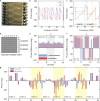Nonreciprocal surface plasmonic neural network for decoupled bidirectional analogue computing
- PMID: 40830354
- PMCID: PMC12365158
- DOI: 10.1038/s41467-025-63103-z
Nonreciprocal surface plasmonic neural network for decoupled bidirectional analogue computing
Abstract
To address the burgeoning demand for computing capacity in artificial intelligence, researchers have explored optical neural networks that show advantages of ultrafast speed, low power consumption, ultra-high bandwidth, and high parallelism. However, most existing optical networks are reciprocal, where forward and backward propagation are intrinsically coupled. This results in the backward pathway remaining largely unexplored, hindering the realization of integrated perception-response systems. Here, we present a nonreciprocal neural network leveraging enhanced magneto-optical effect in spoof surface plasmon polaritons transmission line to decouple forward and backward paths. Moreover, the computing function of the network can be flexibly modulated by the magnetization orientation in ferrites and variations in operating frequency. We demonstrate broadband bidirectional decoupled image processing across various operators, where the operator configuration can be precisely designed by encoding the input signals. This decoupling achieves independent control and signal isolation within the same structure, effectively emulating the unidirectional transmission of biological networks. Furthermore, matrix-solving operations can be facilitated by incorporating feedback waveguides for desired recursion paths. Our findings open pathways to nonreciprocal architectures for independent bidirectional algorithms in analogue computing.
© 2025. The Author(s).
Conflict of interest statement
Competing interests: The authors declare no competing interests.
Figures





Similar articles
-
Short-Term Memory Impairment.2024 Jun 8. In: StatPearls [Internet]. Treasure Island (FL): StatPearls Publishing; 2025 Jan–. 2024 Jun 8. In: StatPearls [Internet]. Treasure Island (FL): StatPearls Publishing; 2025 Jan–. PMID: 31424720 Free Books & Documents.
-
Prescription of Controlled Substances: Benefits and Risks.2025 Jul 6. In: StatPearls [Internet]. Treasure Island (FL): StatPearls Publishing; 2025 Jan–. 2025 Jul 6. In: StatPearls [Internet]. Treasure Island (FL): StatPearls Publishing; 2025 Jan–. PMID: 30726003 Free Books & Documents.
-
Principles and metrics of extreme learning machines using a highly nonlinear fiber.Nanophotonics. 2025 Jun 26;14(16):2733-2748. doi: 10.1515/nanoph-2025-0012. eCollection 2025 Aug. Nanophotonics. 2025. PMID: 40800247 Free PMC article.
-
Assessing the comparative effects of interventions in COPD: a tutorial on network meta-analysis for clinicians.Respir Res. 2024 Dec 21;25(1):438. doi: 10.1186/s12931-024-03056-x. Respir Res. 2024. PMID: 39709425 Free PMC article. Review.
-
Behavioral interventions to reduce risk for sexual transmission of HIV among men who have sex with men.Cochrane Database Syst Rev. 2008 Jul 16;(3):CD001230. doi: 10.1002/14651858.CD001230.pub2. Cochrane Database Syst Rev. 2008. PMID: 18646068
References
-
- Jordan, M. I. & Mitchell, T. M. Machine learning: trends, perspectives, and prospects. Science349, 255–260 (2015). - PubMed
-
- Chen, H. et al. Vanillanet: the power of minimalism in deep learning. Adv. Neural Inf. Process. Syst. 36, 7050–7064 (2024).
-
- Yang, H. et al. Off-resonance spin-locked metasurfaces empowered by quasi-bound states in the continuum for optical analog computing. Adv. Funct. Mater.33, 2305110 (2023).
-
- Gill, S. S. et al. Modern computing: vision and challenges. Telemat. Inform. Rep. 13, 100116 (2024).
LinkOut - more resources
Full Text Sources

